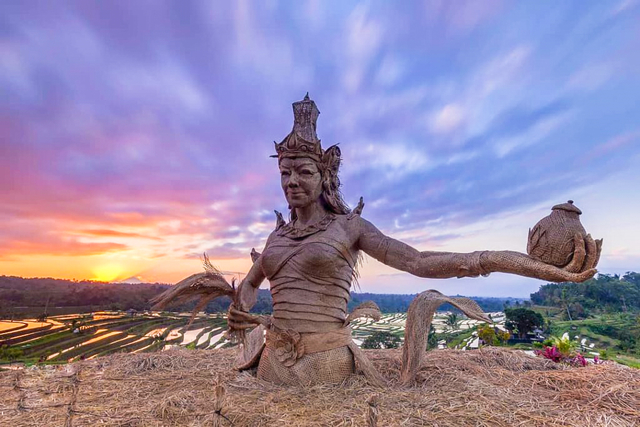
Rice in Indonesia is so central to everything that even now, many inhabitants of the country revere a special goddess of rice and fertility, Dewi Sri.
In Bali, the name of the goddess Dewi Sri is carried by a street and a food court in Kuta, as well as an alley and a shop in Tibubeneng (Berawa).
The goddess of rice and fertility, Dewi Sri (Dewi literally means goddess), is a Javanese, Sundanese, and Balinese pre-Hindu and pre-Islamic deity associated with rice and fertility.
She is still worshipped on the islands of Java, Bali, and Lombok in Indonesia.
The cult of the rice goddess originates from the prehistoric domestication, development, and spread of rice cultivation in Asia brought by Austronesian populations that migrated and settled in the archipelago.
Similar but slightly different mythologies about the rice spirit are widespread among Indonesian ethnic groups and in neighboring countries.
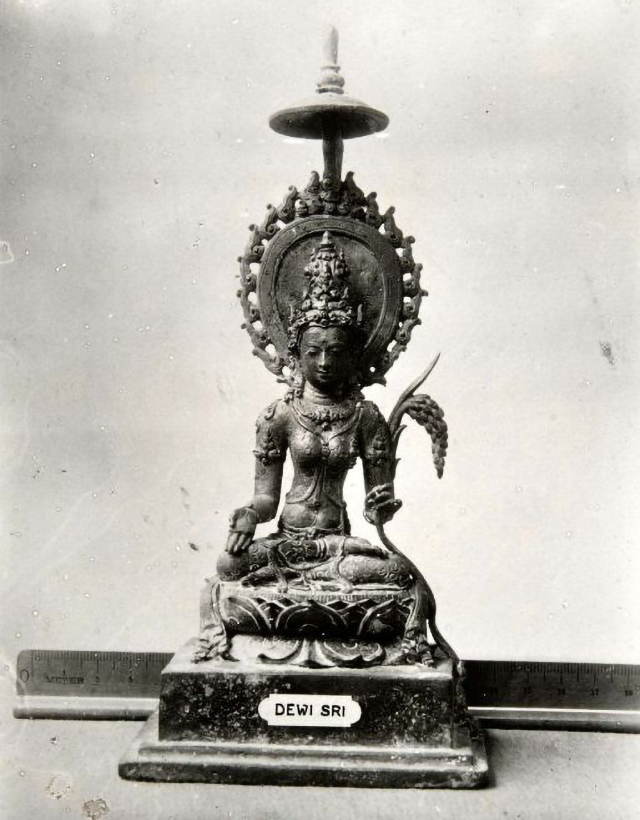
The mythology of Dewi Sri is native to the island of Java.
After the adoption of Hinduism in the archipelago in the first century, she began to be equated with the Hindu goddess Sri Lakshmi and often seen as an incarnation or one of her manifestations. Both Dewi Sri and Lakshmi were associated with wealth and family prosperity.
Subsequently, many depictions of Dewi Sri took on the typical style of the Hindu goddess Lakshmi and her aesthetics.
Believers consider Dewi Sri to reign over rice, the primary staple of Indonesians. Therefore, she symbolizes life, wealth, or prosperity.
In ancient times, rice surpluses multiplied the wealth of kingdoms in Java, such as Mataram, Majapahit, and Pajajaran; while scarcity brought poverty, hunger, and disease.
Mythology of Dewi Sri
According to the legend, rice has a very interesting origin.
Once in the heavens, Batara Guru, the supreme god, commanded all the gods and goddesses to contribute in order to build a new palace. Anyone who disobeyed this command could be considered lazy and lose their hands and feet.
Upon hearing Batara Guru's command, one of the gods, Antaboga, became very distressed. He had the form of a snake and couldn't participate in the construction of the palace.
He sought advice from Batara Narada, Batara Guru's younger brother. But Narada was puzzled by Antaboga's predicament. The snake became very upset and started to cry.
As he cried, three teardrops fell to the ground. Upon touching the earth, these tears transformed into three beautiful radiant eggs, resembling gemstones or pearls. Batara Narada advised him to offer these "gems" to Batara Guru, hoping that this gift would soften his heart, and he would make a fair decision regarding Anta's disability.
With the three eggs in his mouth, Anta headed to the palace. On his way, an eagle approached him and asked a question. Anta remained silent and couldn't respond because he held the eggs in his mouth.
Thinking that Anta was being arrogant, the bird became furious and started to attack Anta. One egg fell to the ground and shattered into pieces. The second attack left Anta with only one egg, which he could present to Batara Guru.
Two broken eggs fell to the ground and transformed into two boars.
Finally, Antaboga arrived at the palace and offered his tear in the form of a shiny egg to Batara Guru. The offer was kindly accepted, and Batara Guru asked the snake to guard the egg until it hatched. A very beautiful girl hatched from the egg. He gave the girl to Batara Guru and his wife.
They named her Nyi Pohaci Sanghyang Asri, and over the years, she grew into a beautiful princess. She captivated all the gods who saw her, including her adoptive father, Batara Guru.
Seeing Batara Guru's passion for his adoptive daughter, the gods became greatly concerned. Fearing that this scandal could disrupt harmony in the heavens, they conspired and poisoned the princess.
The princess's body was buried in a distant and secluded place. However, due to the innocence and divinity of the girl, a miraculous sign appeared at her grave.
Several beneficial plants grew from her burial site, which would forever bring benefits to humanity. From her head grew the coconut palm; from her nose, lips, and ears grew spices and vegetables; from her hair grew grass and flowering plants; from her chest grew fruit-bearing plants; from her arms and hands grew teak and other trees; from her genitals grew the sugar palm; from her hips grew various types of bamboo; from her legs grew tuberous plants, and finally, from her navel grew rice.
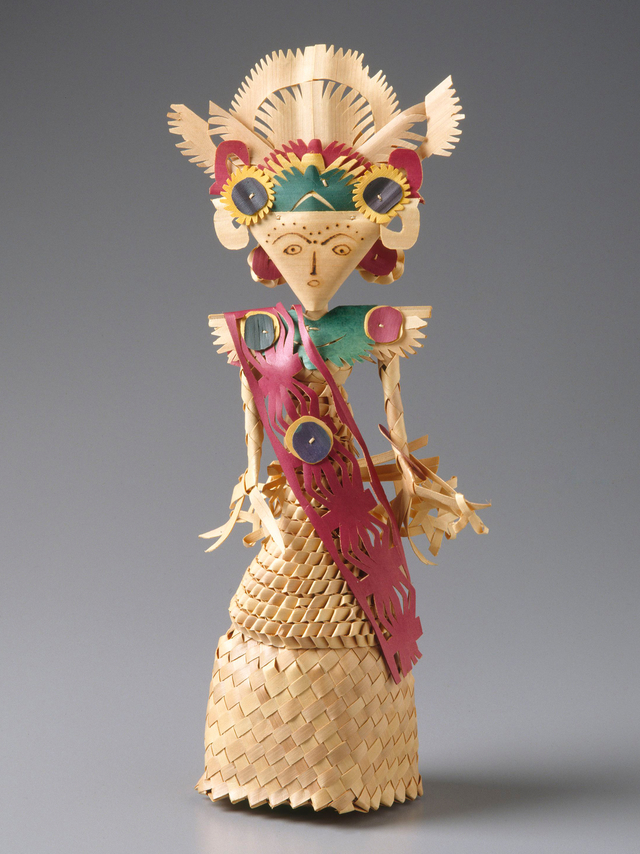
Figurine of Dewi Sri from the collection of the Museum of Applied Arts and Sciences.
According to some myths, white rice grew from her right eye, and red rice from her left eye. It is believed that all useful plants necessary for human well-being and prosperity originate from the remains of Dewi Sri's body.
The inhabitants of the island of Java revered and worshiped her as a benevolent goddess of rice and fertility. In the ancient Sundanese kingdom, she was considered the supreme goddess.
In most myths about Dewi Sri, both Dewi Sri (also known as Dewi Asri, Nyi Pohaci) and her brother Sedana (also known as Sedhana, Sadhana, Sadoño) are mentioned.
In all versions where Sedana appears alongside Dewi Sri, they end up separated from each other: either by death, wandering, or a refusal of marriage.
Images of Dewi Sri.

Dewi Sri is always depicted as a young, beautiful, slender, yet voluptuous woman, representing the peak of femininity and fertility.
In Javanese sacred art, Dewi Sri is typically portrayed wearing green, white, or golden-yellow attire adorned with royal ornaments, much like the Hindu goddess Lakshmi. She holds a rice plant with rice grains in one of her hands.
High Javanese culture demands that she be depicted with a fair complexion, delicately downturned eyes, and a serene facial expression.
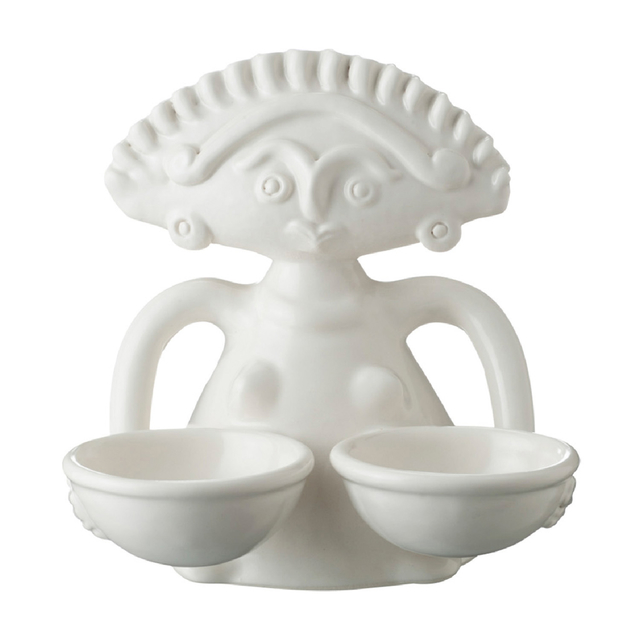
Rituals and Customs in Honor of Dewi Sri
Dewi Sri continues to be highly revered by Javanese, Balinese, and Sundanese people in Indonesia. Throughout Indonesia, there are numerous regional counterparts or variations of the legend about the goddess of rice and fertility.
Despite the fact that the majority of Indonesians are Sunni Muslims, and the people of Bali follow Hinduism, the indigenous beliefs from the animistic era remain very strong. They are worshipped in parallel with Islam, Buddhism, Hinduism, and Christianity. This is evident in the tradition of worshipping the goddess Dewi Sri.
Traditional Javanese engaged in harvest often have a small shrine in their homes called "Pasrean" (Place of Sri), dedicated to Dewi Sri, adorned with her bust, idol, or similar representation.
This sanctuary is usually adorned with intricate depictions of snakes in honor of the snake Antaboga.
Among rural Javanese, there's a folk belief that if a snake enters the house, it should not be driven away. Instead, offerings should be made to it, as the presence of the snake is considered an auspicious sign for a successful harvest.
Both Javanese and Sundanese people have a traditional ceremony called "Mapag Sri" before rice harvesting. "Mapag Sri" translates to "calling or inviting Sri." During the ceremony, people summon the spirit of Dewi Sri to come to their village. They also pray to her for an upcoming successful harvest.
Among the Sundanese, there is still a festival dedicated to Dewi Sri. It is the annual rice harvest festival known as "Seren Taun."
During the blessing ceremony of rice seeds before planting or during the harvest ceremony, the Sundanese sing specific songs. These songs are meant to invite the goddess to descend to the earth and bless the rice seeds and farmers, in order to prevent misfortune.
Balinese people set up special altars in the rice fields dedicated to Dewi Sri.
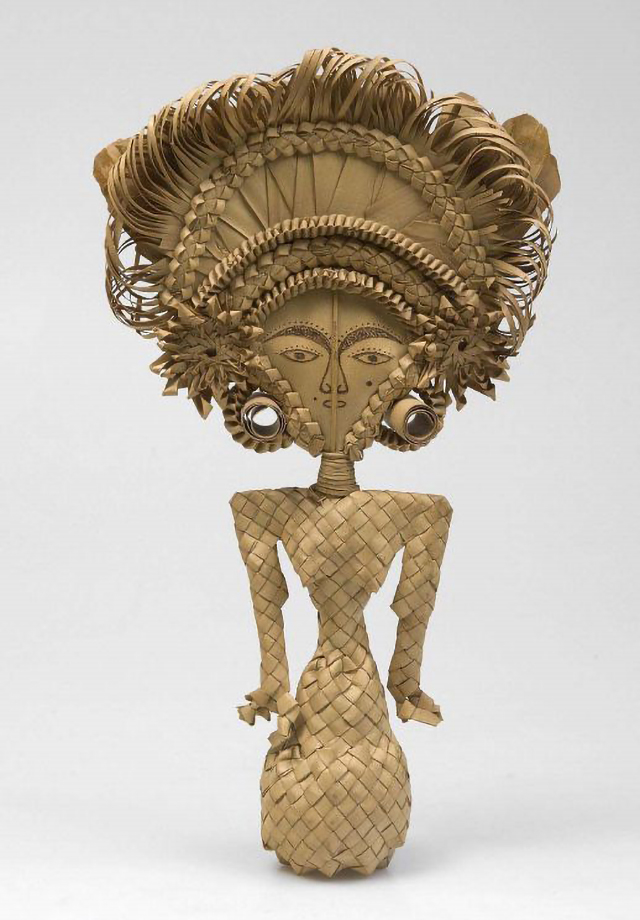
Woven figurine of Dewi Sri from the year 1937. The figurine of the rice goddess is often made from woven janur (young coconut leaf), or pandan leaf, or colorful sticky rice, and is called "chili" (cili).
You can add one right now!